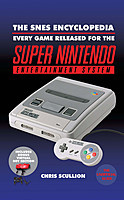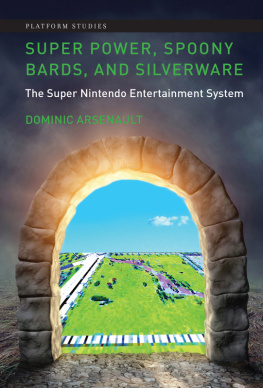Title Page
101 AMAZING NINTENDO NES FACTS
by
Jimmy Russell
Publisher Information
Published in 2012 by
Andrews UK Limited
www.andrewsuk.com
The right of Jimmy Russell to be identified as the Authors of this Work has been asserted by him in accordance with the Copyright, Designs and Patents Act 1998
Copyright 2012 Jimmy Russell
All rights reserved. No part of this publication may be reproduced, stored in a retrieval system, or transmitted, in any form or by any means without the prior written permission of the publisher, nor be otherwise circulated in any form of binding or cover other than that in which it is published and without a similar condition being imposed on the subsequent purchaser. Any person who does so may be liable to criminal prosecution and civil claims for damages.
Disclaimer: Publicly available sources confirm the attribution of these credits, however the authors will be happy to correct any errors. All quotations are subject to applicable fair use laws.
Introduction
In this fact-filled installment in Jimmy Russells Games Console History series, we learn 101 amazing facts about Nintendos seminal NES, the most significant console in Nintendo history.
The facts cover many areas, including the history, the hardware, game titles both rare and popular and some incredible information you probably never knew! Everyone from retro gamers who were there at the time to n00bz who think a PlayStation is Old School will find this excellent eBook jam packed full of fascinating trivia!
History Part One
- The NES is not Nintendos first ever console - that honour belongs to the Color TV Game .
- Whilst it followed the Color TV Game, the Nintendo Entertainment System was succeeded by the SNES.
- The machine was designed by Masayuki Uemura, the head on Nintendo R&D2.
- Uemura had previously developed solar cell technology at Sharp - technology which was later assimilated by Nintendo for their beam-gun games.
- The Nintendo Famicom was launched on July 15 th 1983 in Japan.
- Originally Nintendo approached US-based console giants Atari to release the Famicom as a white-label Atari product, which would be named the Nintendo Advanced Video Gaming System .
- The deal fell through due to a violation of Ataris then-exclusive publishing deal with Nintendo after Coleco demonstrated Donkey Kong on their upcoming Adam machine.
- The American press were sceptical that a Japanese console would do well in the States - the great crash had all but wrecked the market for gaming and Nintendos move was described as miscalculated.
- Regardless of their cold feet, Nintendo launched the NES North America on October 18 th , 1985;
- The European release date was almost a year later - September 1 st , 1986.
Peripherals
- Possibly the most famous NES add-on was the R.O.B - the Robotic Operating Buddy . R.O.B was used to legitimise the NES as an edutainment product, rather than a toy. R.O.B. is capable of playing two games - Gyromite and Stack Up . He receives commands from special flashes from a CRT TV screen and is capable of six individual commands.
- The NES Zapper - the light gun - was available at launch and always came with fan-favourite Duck Hunt .
- The NES Satellite was a truly forward-thinking piece of kit. Used as a wireless adapter, players can plug their NES controller into the Satellite and it then connects wirelessly (via infrared) with the console. It even has space for four controllers so theres room for everyone!
- A wired version was released called the NES Four Score , although this was really just a multitap and wasnt as popular.
- The Power Pad (called the Family Trainer in Japan) was an official controller from Bandai. It was a precursor to the dance mats of the 2000s, only twenty years earlier! The Power pad was double-sided so it had a wider degree of compatibility.
- For those who favour a more arcade-friendly feel, the NES Advantage is the controller for you. A large, flat joystick with mounted buttons and turbo fire options, the Advantage is a great addition to any collection.
- If you dont like the traditional oblong NES pad, consider the NES Max . Thinner and with a more ergonomic design, instead of a d-pad the Max has a circular cycloid and its turbo buttons are even faster than the Advantage!
- Probably the most failed peripheral of its era is the U-Force by Broderbund. A wireless, infrared-sensor tried to convert the movement of the gamers hand into controller input. Even though it looked the part, unfortunately the controller was a bit rubbish.
- 1989 saw the release of possibly the most famous NES peripheral - the Power Glove . Imprecise and difficult to use, the glove was supposed to take gamers one step closer to virtual reality. Using a carbon-rich ink in combination with optical fibres, the optical sensors can tell when the gloves fingers are bent - and how bent they are - as the ink compresses and transmits less light. There are 256 positions per finger and this input is then transmitted over a 40kHz ultrasonic sound wave which also transmits the yaw and roll of the glove using complex triangulation calculations. Incredible science used poorly and supported by only two games.
- Not strictly a peripheral but some cartridges of Gyromite and Stack-Up contain surprising treasures within their plastic shell: Many of the games were actually Japanese Famicom games in disguise and the cartridge contains a Japanese-to-American game converter - find one of these, dismantle it and you have an inexpensive way of playing imported games!
Hardware Part One
- In Japan, China and most of Asia the console was actually called the Family Computer or Famicom for short.
- The Famicom had a 60-pin top-loading cartridge slot which differed from the NES.
- Where the NES cartridges were all (except Zelda ) the same grey colour, Famicom cartridges were available in a near-infinite number of colours.
- NES carts are 13cm tall, 12cm wide and 2cm thick - Famicom carts are considerably smaller at 7cm tall and 10cm wide.
- The first Famicom was only capable of outputting RF modulated video - the NES and later the Famicom AV both output composite video via RCA as well as RF.
- In 1986 Nintendo released the Famicom Disk System - a floppy drive which connected to the expansion port on the Famicom. Using their own disks, gamers could buy new games from vending machines and use their own disks, saving money.
- The disks themselves were proprietary 2 double-sided disks - 64k on each side so a total of 128k per disk. Interestingly, the disk wrote data to a single spiral track - unlike floppy disks which use concentric rings of data - so each disk was read in a linear fashion much like a vinyl record.
- Family BASIC was a cartridge that was available for the Famicom - along with a Famicom Keyboard - which allowed users to program their own software for the console.
- Saved software required the use of the Famicom Data Recorder , to save the data to a standard audio tape much like the 8-bit computers of the time. The Data Recorder can also save custom tracks and stages from Excitebike, Wrecking Crew and others.
- Contrary to logic the Famicom Disk System cannot be used alongside the Family Basic as both require the use of the cartridge slot simultaneously.
Top-selling Games
- Super Mario Bros. (40 million)
- Super Mario Bros. 3 (18 million)
- Super Mario Bros. 2 (10 million)
- Tetris (8 million)
- The Legend of Zelda (6.5 million)
- Zelda II: The Adventure of Link (4.4 million)
- Teenage Mutant Ninja Turtles (4 million)
- Metroid (2.8 million)
- R.C. Pro-Am (2.3 million)
- Punch-Out!! (2 million)
Next page


